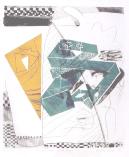|
|
Michael Rothenstein

Michael Rotheninsten Cat. Essay, Wise &
foolish virgins 1966 |
|
line on paper line in space |
|
Agathe Sorel came to England in 1956, shortly
after the revolution in Hungary. She had already studied art in Budapest, doing
stage design, mosaics, and some monumental social realist images, before again
taking up her studies, this time at Camberwell School of Art, in London, where
she pursued a course in graphic design. |
|
On leaving art school she won a much coverted
scholar- ship, the Gulbenkian Grant, which enabled her to work in Paris. This
chance offered an almost exotic glamour to a young artist at that time, and
certainly Agathe felt that. On her return to London it was clear that her stay
in Paris had been of enormous value. She had chosen to work with S W Hayter at
Atelier 17, and under his stimulus she soon became a committed
engraver. |
|
On her return to London two years later much
of the quietness and reserve had gone. Her stay in Paris had conferred a new
confidence and firmness. Her work was likewise firmer and more energetic and
showed already the first uncurlings of those vigorous shoots that have since
formed the basis of her personal style. It was clear that her foot was already
on the ladder: Agathe now held one's regard with a new interest and a new
respect. Back in London she soon found work as a teacher and - more important -
set up her own press. This was a decisive step. For in setting up her own
workshop, Agathe was able to think very consistently in terms of the medium.
Having equipment under her hand enabled her to turn to the workshop at all
hours, night and day, as ideas formed themselves and came alight in her mind.
She was thus able to close the gap - to an exceptional degree - between the
medium and the message. As a result she is able to conceptualise in styles
entirely appropriate to the behaviour of the metal plate under attack from the
various tools, acids and other agents used to shape and engrave the sculptural
landscape of its surface. |
|
Within a few years she won the Churchill
Award to work and travel in the United States, and here she spent some six
months visiting artists' studios, museums, art colleges and universities.
Before returning she also visited Mexico. All this made a further decisive
impression on her work as an engraver. She began exhibiting in some of the more
important shows in England and elsewhere. |
|
Agathe's work combines an imaginative purpose
with an acute awareness of the right technical means to fulfil that purpose -
an awareness, moreover, that is quite exceptional in quality. It is certain
that she is one of the most resourceful workers in the various etching media in
this country. |
|
On a more recent visit to America, she was
given the chance of working in an experimental plastics production plant. An
experience that greately excited her interest in the potential of these
remarkable materials. Since then Agathe has been building sculptures and
constructions, combining the properties of engraving with three dimen- sional
form. In this way she is able to make her linear configurations float, flow or
glide in space. As you walk around these remarkable constructions, the engraved
line appears to wrap around the transparent columns, or to float across the
perspex space frames, and to do this in a manner at once elegant and
purposeful. |
|
"It is line in space moving freely almost
as in weightless atmosphere, enhanced or broken up by the optical effects of
mechanical and hand-made systems". This is how
Agathe herself describes this purpose. |
|
Michael
Rothenstein |
|